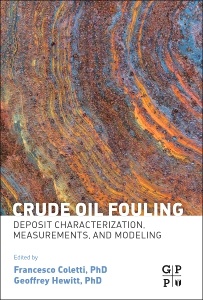Description
Crude Oil Fouling
Deposit Characterization, Measurements, and Modeling
Coordinators: Coletti Francesco, Hewitt Geoffrey
Language: English
Subjects for Crude Oil Fouling:
Keywords
Asphaltene precipitation; Asphaltenes; ATR-FTIR; Autoxidation; Characterization of fouling deposits; Chemical imaging; Computational fluid dynamics; Corrosion; Cost of fouling; Crude distillation unit; Crude oil compatibility; Crude oil fouling; Direct numerical simulation; Dynamic gauging; Elemental analysis; Events in fouling; Fouling deposits; Fouling economics; Fouling experiment; Fouling impact; Fouling measurements; Fouling mechanisms; Fouling rate; Fouling science; Fouling under controlled conditions; Heat exchanger; High pressure oil rig; HIPOR; Laminar flow; Large eddy simulation; Microbomb; Multiscale modeling; Preheat train; Recommended refinery practice; Refinery; Stirred cell; Thermogravimetric analysis; Thickness; Turbulent flow; Variables affecting fouling
360 p. · 15x22.8 cm · Hardback
Description
/li>Contents
/li>Biography
/li>Comment
/li>
With production from unconventional rigs continuing to escalate and refineries grappling with the challenges of shale and heavier oil feedstocks, petroleum engineers and refinery managers must ensure that equipment used with today?s crude oil is protected from fouling deposits Crude Oil Fouling addresses this overarching challenge for the petroleum community with clear explanations on what causes fouling, current models and new approaches to evaluate and study the formation of deposits, and how today?s models could be applied from lab experiment to onsite field usability for not just the refinery, but for the rig, platform, or pipeline.
Crude Oil Fouling is a must-have reference for every petroleum engineer?s library that gives the basic framework needed to analyze, model, and integrate the best fouling strategies and operations for crude oil systems.
List of Contributors Preface ix Nomenclature
1. Introduction 1.1 Crude Distillation Units in Oil Refineries 1.2 Impact of Fouling on Crude Distillation Units 1.3 Concluding Remarks
2. Basic Science of the Fouling Process 2.1 Fouling Mechanisms 2.2 Routes to Crude Oil Fouling Formation 2.3 Events in Crude Oil Fouling 2.4 Variables Affecting Fouling 2.5 Conclusions
3. Experimental Generation of Fouling Deposits 3.1 Small Scale, Accelerated Conditions: Microbomb Fouling Tests 3.2 Batch System: Stirred Cell at the University of Bath 3.3 Large-Scale Experiments in Flow Systems
4. Deposit Characterization and Measurements 4.1 Analysis of Field Fouling Deposits from Crude Heat Exchangers 4.2 Chemical Structure and Molecular Weight Characterization 4.3 Chemical Imaging of Deposited Foulants and Asphaltenes 4.4 Fluid Dynamic Gauging: Thickness and Strength Measurements
5. Modeling of Fouling from Molecular to Plant Scale 5.1 Review of Heat Exchanger Design Methodologies and Mathematical Models of Fouling 5.2 Thermodynamic and Molecular Modeling 5.3 Fundamental Transport Modeling 5.4 Industrial Scale High-Fidelity Modeling
6. Concluding Remarks
Appendix 1 References Index
Professor Hewitt is an Emeritus Professor of Chemical Engineering at Imperial College London. Professor Hewitt has worked on a variety of subjects in the general field of chemical engineering but his speciality for several decades now has been in mutliphase flow systems, with particular reference to channel flow and heat transfer. He has published many papers and books in this industrially important area and has lectured on the subject widely throughout the wo
- Defines the most critical variables and events that cause fouling
- Explains the consequences of fouling and its impact on operations, safety, and economics
- Provides the technical models available to better predict and eliminate the potential for fouling in any crude system




